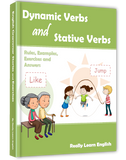Dynamic verbs and stative verbs: rules, examples and usage (25 pages)
Share this product
The guide to dynamic verbs (action verbs) and stative verbs, including: rules, examples, exercises and answers.
Stative Verbs
Stative verbs are verbs that express a state rather than an action.
Examples:
be, seem, love, own, want, sound, have, know, understand.
Emily is sad.

Dynamic Verbs
Dynamic verbs are the opposite of stative verbs. They express a real action.
Examples:
Jump, swim, catch, write, call, sleep, hit, open, speak.
John cries.

Get this booklet to help your students fully understand stative and dynamic (action) verbs.






